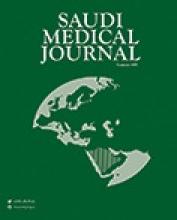Abstract
OBJECTIVE: To identify the pattern of renal pathology among renal biopsy specimens, and to study the clinical correlation in a general hospital in the eastern region of the Kingdom of Saudi Arabia.
METHODS: All patients who underwent native kidney biopsy by the author at Dhahran Health Center (DHC) between June 1998 and April 2005 were included and prospectively followed-up.
RESULTS: One hundred native kidney biopsies were performed on 95 patients with a mean age of 40.8 ± 18 years, and a glomerular filtration rate of 57 ± 42 ml/min/1.73 m2. Patients were followed up for a mean of 28 ± 22.5 months. Primary renal pathology was identified in 72 specimens and secondary in 28. Primary renal pathologies included focal and segmental glomerulosclerosis (FSGS) (35%), immunoglobulin A nephropathy (IgAN) (14%), tubulo-interstitial nephritis (12%), minimal change disease (10%), membranous nephropathy (4%), mesangioproliferative glomerulonephritis (6%), mesangiocapillary glomerulonephritis (4%), thin glomerular basement membrane disease (8%), and miscellaneous (7%). Secondary lesions included lupus nephritis (LN) (36%), sickle cell nephropathy (SCN) (18%), diabetic nephropathy (14%), hypertensive nephrosclerosis (11%), Henoch Schonlein purpura (7%), and miscellaneous (14%). Obesity was particularly prevalent among patients with FSGS. Among the entire group, 12 patients (13%) progressed to end stage renal disease (ESRD) at a mean of 17.6 ± 17 months (range, 1-45 months), and the overall mortality rate was 5.3%.
CONCLUSION: At DHC, FSGS was the most common primary renal pathology, followed by IgAN. There was an association between FSGS and obesity. Lupus nephritis was the predominant secondary renal pathology followed by SCN. Within the time of follow up, primary renal lesions were associated with a low rate of progression to ESRD.
- Copyright: © Saudi Medical Journal
This is an open-access article distributed under the terms of the Creative Commons Attribution-Noncommercial-Share Alike 3.0 Unported, which permits unrestricted use, distribution, and reproduction in any medium, provided the original work is properly cited.






